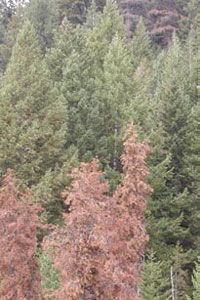 Beetles are killing BC forests. It’s an environmental and industrial disaster. Ministry of Forests’ solution? Inject thousands of unmarked trees with arsenic. Then, ignore the consequences as loggers fall the trees and beehive burners spread the arsenic sky-high.
Beetles are killing BC forests. It’s an environmental and industrial disaster. Ministry of Forests’ solution? Inject thousands of unmarked trees with arsenic. Then, ignore the consequences as loggers fall the trees and beehive burners spread the arsenic sky-high.
by Delores Broten
Appeals to common sense, the precautionary principle, the Environmental Appeal Board, public agitation and internal ministry reviews all failed Josette Wier. The Smithers resident, from her home in northern BC, has struggled since 2000 against the Ministry of Forest’s (MoF) desperate attempt to use arsenic against the Mountain Pine Beetle infestation of BC forests.
Four million hectares of B.C. forests were attacked by the mountain pine beetle in 2002 (MoF) and NASA climate researcher Chris Potter now estimates the size of the infestation to be almost 10 million hectares. The beetle, a natural predator, thrives in the warm winters of recent years, and needs several weeks of deep freezing temperatures to control population growth. That hasn’t happened for over a decade, probably due to climate change.
Although harvesting beetle kill, and potential beetle kill, is fueling a temporary boom for the interior logging industry, its implication for long-term sustainability of that industry is dire.
So the MoF, in its wisdom, desperation, or drug-dependency, decided to inject beetleinfested trees with monosodium methanearsenate (MSMA) in an attempt to halt the bugs’ advance.
Enter Josette. “I was appalled,” she says. “In France, I was a pediatrician and I knew what arsenic would do to children.” Her angst grew when she learned the injected trees were being logged and their waste bark burned in beehive burners.
Wier used all the strings and levers available to the citizen fighting a lonely battle against a seemingly-insane bureaucratic action. Phone calls, letters, an appeal to the Environmental Appeal Board (hampered because the “pesticide” is currently approved by Health Canada, although not for burning), an investigation by the Canadian Wildlife Service of woodpeckers accumulating arsenic from the beetles not killed by MSMA, all failed. The Forest Practices Board weighed in and backed her up. Internal investigations and audits by the Ministries of Forest and Water Land and Air Protection agreed there was a problem with using the arsenic in areas where the trees were then logged. The Pesticide Management Regulatory Agency admitted it was re-evaluating the safety of MSMA, and the company refused to pay for further safety studies (Peculiarly, MoF, enamoured of its deadly fix, offered to pay for the work.) Nothing had any effect, and nothing made the bureaucrats or the media take notice.
Then Wier got lucky.
She filed a complaint with certification auditor KPMG (Performance Registrar Inc.) about Canfor’s logging and burning of arsenic-treated trees, and about Canfor’s treatment of her complaints.
Canfor proudly holds International Standards Organization 14001 (ISO) certification, which requires environmental management of their forest operations. ISO certification is pretty well a marketplace requirement for quality control. KPMG is the responsible auditor. Not surprisingly, the beehive burners aren’t certified, but the wood products must be handled in compliance with all permits. MWLAP told KPMG that burning arsenic was definitely not included in the Canfor air pollution permits. KPMG (PRI) decided Canfor had been less than polite with Wier’s “emotionally charged” complaints.
And voila! Bingo! The auditor decided it was all a bit too much.
KPMG has given Canfor 30 days to decide how it is going to stop burning arsenic contaminated wood waste in order to comply with its ISO 14001 certification. In addition, the auditor noted “the issues related to communication [with the public] will also be reviewed in detail during the next site visit to verify that the Company is taking steps to address this concern.”
The ruling doesn’t deal with other arsenic-injected BC forest areas.
Doesn’t deal with outdated and dangerous pesticide approvals.
Doesn’t deal with MoF or the new Chief Forester, Jim Snetsinger, the regional manager under whose watch this all took place.
Doesn’t deal with all those kilograms, possibly thousands of kilograms, of arsenic out there in the trees, and the woodpeckers snacking on arsenic-flavoured beetles.
Nor does it help any children of BC affected by air-borne arsenic, nor the loggers and sawmill workers dealing with the trees.
Doesn’t stop the next dumb idea coming down the pipe.
But you can bet the phone line is burning hot and heavy between Canfor headquarters and Victoria this month.
Salut, Josette!
Josette Wier runs Chez Josette bed and breakfast in Smithers BC. She is a pediatrician and a member of Canadian Association of Physicians for the Environment.
***
See Also: Forest Practices Board Report Nov 2004, Nadina Beetle Treatments: http://www.bcfpb.ca/reports-publications/reports/nadina-beetle-treatments Environmental Appeal Board: http://www.eab.gov.bc.ca/pest/ 2001pes003b.pdf “Mountain Pine Beetle: Nature’s Disaster Relief Troops,” Watershed Sentinel, August/November 2001 and “What’s the Buzz on Beetles?” October/November 2000
[From WS January/February 2005]

